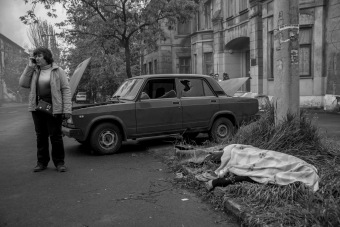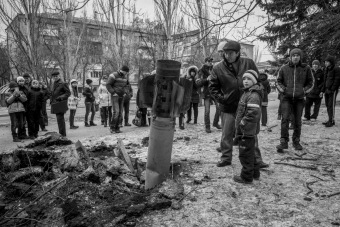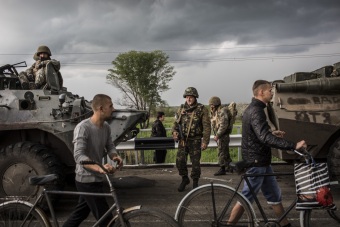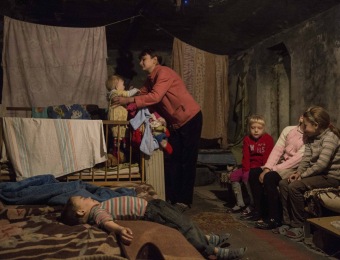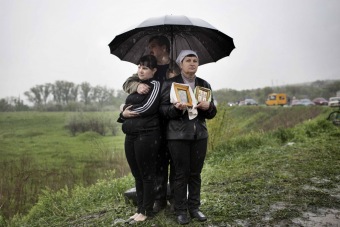Francesca Volpi
We are in Mariupol. In a devastated street, next to a crashed car a woman calls for help on the phone. At a second glance we notice the corpse of a man lying on the pavement, already covered by a sheet. A casualty of the war in Ukraine, which Francesca Volpi has been following from 2014 to 2016 after the first revolutionary movements against Russia’s annexation of Crimea.
In Kramatorsk a group of people look with curiosity at an unexploded missile that has fallen in the middle of the garden of the council block of flats where they live. It is a scene from any day in the war in Ukraine, which Francesca Volpi has been following from 2014 to 2016 after the first revolutionary movements against Russia’s annexation of Crimea.
Two young men on bicycles and a woman in the background with shopping bags, pass a checkpoint controlled by soldiers in tanks. It is a scene from any day in the war in Ukraine, which Francesca Volpi has been following from 2014 to 2016 after the first revolutionary movements against Russia’s annexation of Crimea.
A Ukrainian family fleeing near the city of Sloviansk gathers with their dearest and most precious belongings to shelter from the rain and horror. It is a scene from any day in the war in Ukraine, which Francesca Volpi has been following from 2014 to 2016 after the first revolutionary movements against Russia’s annexation of Crimea.
FRANCESCA VOLPI works with the most important international publications on social themes and on-going conflicts, travelling from the borders of the Balkans to the east of China, Cambodia, Vietnam. She is the youngest freelancer to follow the war of the annexation of Crimea from the first revolutionary movements in Kiev in 2014. She approached photography after graduating in journalism at the London College of Communication. Among her recent photo-investigations, she captured images in 2015 of the rebellion of the inhabitants of Tixtla against the narcos, following the story of 43 students desaparecidos; in Honduras in 2016 she told the story of the farming conflict on the Atlantic coast of the country. Chosen by the “International Women’s Media Foundation” in 2016, she realised two photo essays in the Democratic Republic of the Congo: one on a juvenile prison in the city of Goma; another on women in Congolese society. *She was born in 1985 in Brescia, she lives and works in Paris and Rome.

